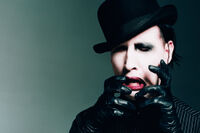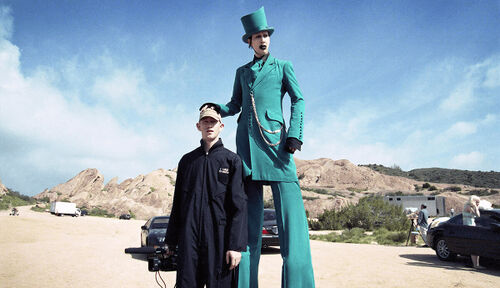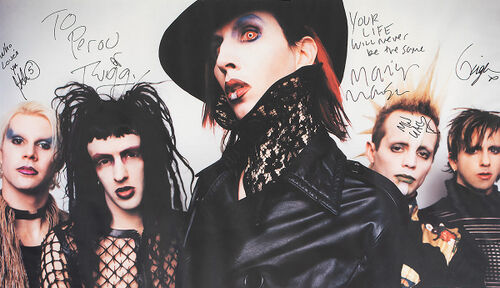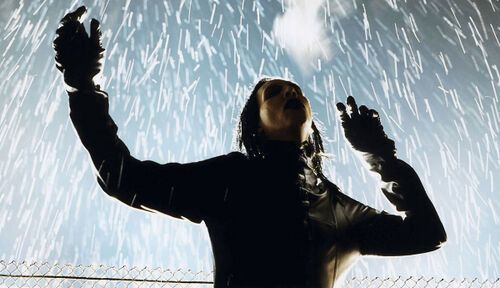Interview:2020 Manson ‡ Perou: 21 Years in Hell. Special Feature
| Manson ‡ Perou: 21 Years in Hell. Special Feature | ||
|---|---|---|

|
||
| Interview with Perou | ||
| Date | 2020 | |
| Source | marilynmanson.fr | |
| Interviewer | Vince | |
- There’s no doubt you have already seen Marilyn Manson images taken by British photographer PEROU. He is the one who shot the Heaven Upside Down cover and his always epic photographs were used for Mechanical Animals, Holy Wood, Golden Age of Grotesque, EAT ME DRINK ME and Heaven Upside Down promotional campaigns. He even photographed Manson for the 2005 Vivienne Westwood collection and for many magazine covers including Time Out, KERRANG! and Metal Hammer. Last but not least, he was involved in the production of both God is in the TV and Guns God and Government tour films. We had the opportunity to talk to PEROU about his twenty-one years of collaboration with Marilyn Manson and how it resulted in the 21 Years in Hell book, coming out next month.
FOR THE UNINITIATED MARILYN MANSON FANS, COULD YOU TELL US WHO YOU ARE?
I am an English photographer. I mainly photograph people, although recently I’ve been photographing tigers, lions and other big cats in a studio. I set up inside a lion’s den.
WHAT MADE YOU WANT TO BECOME A PHOTOGRAPHER?
I was thinking about becoming a lorry driver or a Christian missionary in Africa, but had a crisis of faith and had a reality check that driving lorries in England wouldn’t be like driving big rigs across America in the 1970’s film Convoy. I became a photographer by accident, it was something I was a little bit good at and enjoyed. I still love making pictures, it’s my passion and obsession.
CAN YOU TELL US ABOUT THE FIRST TIME YOU PHOTOGRAPHED MANSON IN AMSTERDAM IN 1998, HOW DID IT GO?
Actually the first shoot was in Los Angeles in 1998. I was asked to photograph Manson by Time Out magazine for their Easter issue. The picture on the cover ran with the byline Jesus Christ?. I was already a fan of Manson’s music, I’d been listening to Smells like Children as loud as it would go, driving round London in my 1982 TransAm, with the roof off.
SINCE THEN, YOU HAVE PHOTOGRAPHED HIM MORE THAN ANYONE ELSE. WE COUNTED AROUND FIFTY DIFFERENT PHOTO SESSIONS, I GUESS YOU NOW HAVE SOME KIND OF RITUAL?
Wow, I never counted, myself. Not sure about a ritual? I never come to any shoot, whoever it is, with firmly, pre-conceived ideas. I think if you plan too much, it will always be different anyway or if you plan too much and stick to your plan, you waste opportunities for magik which you would never have been able to predict or imagine before. Magik happens in photography when you let it happen. Sometimes I badly sketch ideas or lighting scenarios but essentially all my shoots are freestyle, sometimes around a theme or an idea.
The first time I photographed Manson I was probably nervous because he was an American rock star and I was a young photographer from England without much experience. Over the years we have got to know each other quite well, so we know what we can expect of each other. Remarkably then, we are not stuck in a groove where we repeat the same thing over and over again.
As you’ll have seen, every time we shoot is different, you can probably tell I shot the picture but Manson is always evolving. Sometimes I don't like to photograph people more than once. I always enjoy photographing Manson. A lot of photographers have a creative vision for someone they’re photographing that they want to impose on them. I have always understood that Manson is an artist who doesn’t need too much input from me telling him what to do. Sometimes I tell him if something doesn’t look good to me: an outfit or a pose but often I am just trying to keep up with him and photograph what he presents to me without interfering too much myself.
Don’t want to step in the way of greatness, just catch it on camera. Jay-Z once told me, when I’d be telling him what I wanted him to do on the shoot, « It’s not about you, it’s about me », and that was brilliant advice for a photographer. Photographers need to understand the photo isn’t about them it’s about who they’re photographing, unless it’s a selfie.


